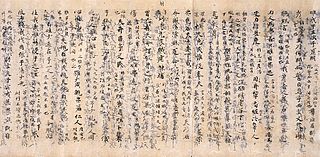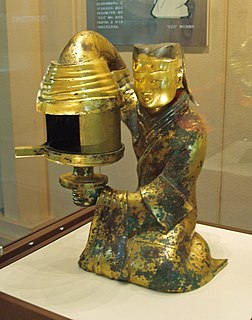Chinese classic texts or canonical texts or simply dianji (典籍) refers to the Chinese texts which originated before the imperial unification by the Qin dynasty in 221 BC, particularly the "Four Books and Five Classics" of the Neo-Confucian tradition, themselves a customary abridgment of the "Thirteen Classics". All of these pre-Qin texts were written in classical Chinese. All three canons are collectively known as the classics.

劉 / 刘 is an East Asian surname. pinyin: Liú in Mandarin Chinese, Lau4 in Cantonese. It is the family name of the Han dynasty emperors. The character 劉 originally meant 'kill', but is now used only as a surname. It is listed 252nd in the classic text Hundred Family Surnames. Today, it is the 4th most common surname in Mainland China as well as one of the most common surnames in the world.

The Nine Chapters on the Mathematical Art is a Chinese mathematics book, composed by several generations of scholars from the 10th–2nd century BCE, its latest stage being from the 2nd century CE. This book is one of the earliest surviving mathematical texts from China, the first being Suan shu shu and Zhoubi Suanjing. It lays out an approach to mathematics that centres on finding the most general methods of solving problems, which may be contrasted with the approach common to ancient Greek mathematicians, who tended to deduce propositions from an initial set of axioms.

The Records of the Three Kingdoms is a Chinese historical text which covers the history of the late Eastern Han dynasty and the Three Kingdoms period. It is widely regarded as the official and authoritative source historical text for that period. Written by Chen Shou in the third century, the work synthesizes the histories of the rival states of Cao Wei, Shu Han and Eastern Wu in the Three Kingdoms period into a single compiled text.

The Book of Documents or Classic of History, also known as the Shangshu, is one of the Five Classics of ancient Chinese literature. It is a collection of rhetorical prose attributed to figures of ancient China, and served as the foundation of Chinese political philosophy for over 2,000 years.

The Book of Han or History of the Former Han is a history of China finished in 111AD, covering the Western, or Former Han dynasty from the first emperor in 206 BCE to the fall of Wang Mang in 23 CE. It is also called the Book of Former Han.

Mathematics in China emerged independently by the 11th century BC. The Chinese independently developed a real number system that includes significantly large and negative numbers, more than one numeral system, algebra, geometry, number theory and trigonometry.

The Book of the Later Han, also known as the History of the Later Han and by its Chinese name Hòu Hànshū, is one of the Twenty-Four Histories and covers the history of the Han dynasty from 6 to 189 CE, a period known as the Later or Eastern Han. The book was compiled by Fan Ye and others in the 5th century during the Liu Song dynasty, using a number of earlier histories and documents as sources.
Liú Ān was a Han dynasty Chinese prince, ruling the Huainan Kingdom, and an advisor to his nephew, Emperor Wu of Han (武帝). He is best known for editing the Huainanzi compendium of Daoist, Confucianist, and Legalist teachings and is credited for inventing tofu. Early texts represent Liu An in three ways: the "author-editor of a respected philosophical symposium", the "bumbling rebel who took his life to avoid arrest", and the successful Daoist adept who transformed into a xian and "rose into the air to escape prosecution for trumped-up charges of treason and flew to eternal life."

The burning of books and burying of scholars, also known as burning the books and executing the ru scholars, refers to the purported burning of texts in 213 BCE and live burial of 460 Confucian scholars in 212 BCE by the Chinese emperor Qin Shi Huang of the Qin dynasty. This was alleged to have destroyed philosophical treatises of the Hundred Schools of Thought, with the goal of strengthening the official Qin governing philosophy of Legalism.

Yang Xiong was a Chinese philosopher, poet, and politician of the Western Han dynasty known for his philosophical writings and fu poetry compositions.

Wang Zhen was a Chinese mechanical engineer, agronomist, inventor, writer, and politician of the Yuan dynasty (1271–1368). He was one of the early innovators of the wooden movable type printing technology. His illustrated agricultural treatise was also one of the most advanced of its day, covering a wide range of equipment and technologies available in the late 13th and early 14th century.

Du Shi was a Chinese hydrologist, inventor, mechanical engineer, metallurgist, and politician of the Eastern Han Dynasty. Du Shi is credited with being the first to apply hydraulic power to operate bellows in metallurgy. His invention was used to operate piston-bellows of the blast furnace and then cupola furnace in order to forge cast iron, which had been known in China since the 6th century BC. He worked as a censorial officer and administrator of several places during the reign of Emperor Guangwu of Han. He also led a brief military campaign in which he eliminated a small bandit army under Yang Yi.

The Song dynasty invented some technological advances in Chinese history, many of which came from talented statesmen drafted by the government through imperial examinations.
The Qimin Yaoshu is the most completely preserved of the ancient Chinese agricultural texts, and was written by the Northern Wei Dynasty official Jia Sixie. The book is believed to have been completed in the second year of Wu Ding of Eastern Wei, 544 CE, while another account gives the completion between 533 and 544 CE.

The Han dynasty of ancient China, divided between the eras of Western Han, Xin dynasty of Wang Mang, and Eastern Han, witnessed some of the most significant advancements in premodern Chinese science and technology.
The Yi Zhou Shu is a compendium of Chinese historical documents about the Western Zhou period. Its textual history began with a text/compendium known as the Zhou Shu, which was possibly not differentiated from the corpus of the same name in the extant Book of Documents. Western Han dynasty editors listed 70 chapters of YZS, of which 59 are extant as texts, and the rest only as chapter titles. Such condition is described for the first time by Wang Shihan 王士漢 in 1669. Circulation ways of the individual chapters before that point are subject to scholarly debates.
Annotations to Records of the Three Kingdoms by Pei Songzhi (372-451) is an annotation completed in the 5th century of the 3rd century historical text Records of the Three Kingdoms, compiled by Chen Shou. After leaving his native land, Pei Songzhi became the Gentleman of Texts under the Liu Song Dynasty, and was given the assignment of editing the book, which was completed in 429. This became the official history of the Three Kingdoms period, under the title Sanguozhi zhu. He went about providing detailed explanations to some of the geography and other elements mentioned in the original. More importantly, he made corrections to the work, in consultation with records he collected of the period. In regard to historical events and figures, as well as Chen Shou's opinions, he added his own commentary. From his broad research, he was able to create a history which was relatively complete, without many of the loose ends of the original. Some of the added material was colourful and of questionable authenticity, possibly fictional. All the additional material made the book close to twice the length of the original. Pei Songzhi scrupulously cited his sources, and always introduced his opinion as such.
After the Jin dynasty was founded, the Jin dynasty rulers imitated the Song dynasty and decided to establish their own carriages and apparel system.











